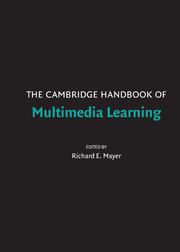Book contents
- Frontmatter
- Contents
- Preface
- Contributors
- 1 Introduction to Multimedia Learning
- PART I THEORETICAL FOUNDATIONS
- PART II BASIC PRINCIPLES OF MULTIMEDIA LEARNING
- PART III ADVANCED PRINCIPLES OF MULTIMEDIA LEARNING
- 14 The Guided Discovery Principle in Multimedia Learning
- 15 The Worked-Out Examples Principle in Multimedia Learning
- 16 The Collaboration Principle in Multimedia Learning
- 17 The Self-Explanation Principle in Multimedia Learning
- 18 The Animation and Interactivity Principles in Multimedia Learning
- 19 Navigational Principles in Multimedia Learning
- 20 The Site Map Principle in Multimedia Learning
- 21 Prior Knowledge Principle in Multimedia Learning
- 22 The Cognitive Aging Principle in Multimedia Learning
- PART IV MULTIMEDIA LEARNING IN CONTENT AREAS
- PART V MULTIMEDIA LEARNING IN ADVANCED COMPUTER-BASED CONTEXTS
- Author Index
- Subject Index
- References
18 - The Animation and Interactivity Principles in Multimedia Learning
Published online by Cambridge University Press: 05 June 2012
- Frontmatter
- Contents
- Preface
- Contributors
- 1 Introduction to Multimedia Learning
- PART I THEORETICAL FOUNDATIONS
- PART II BASIC PRINCIPLES OF MULTIMEDIA LEARNING
- PART III ADVANCED PRINCIPLES OF MULTIMEDIA LEARNING
- 14 The Guided Discovery Principle in Multimedia Learning
- 15 The Worked-Out Examples Principle in Multimedia Learning
- 16 The Collaboration Principle in Multimedia Learning
- 17 The Self-Explanation Principle in Multimedia Learning
- 18 The Animation and Interactivity Principles in Multimedia Learning
- 19 Navigational Principles in Multimedia Learning
- 20 The Site Map Principle in Multimedia Learning
- 21 Prior Knowledge Principle in Multimedia Learning
- 22 The Cognitive Aging Principle in Multimedia Learning
- PART IV MULTIMEDIA LEARNING IN CONTENT AREAS
- PART V MULTIMEDIA LEARNING IN ADVANCED COMPUTER-BASED CONTEXTS
- Author Index
- Subject Index
- References
Summary
Abstract
Computer animation has tremendous potential to provide visualizations of dynamic phenomena that involve change over time (e.g., biological processes, physical phenomena, mechanical devices, and historical development). However, the research reviewed in this chapter showed that learners did not systematically take advantage of animated graphics in terms of comprehension of the underlying causal or functional model. This chapter reviewed the literature about the interface and content features that affect the potential benefits of animation over static graphics. Finally, I proposed some guidelines that designers should consider when designing multimedia instruction including animation.
What Are the Animation Principle and the Interactivity Principle?
In the last decade, with the rapid progression of computing capacities and the progress of graphic design technologies, multimedia learning environments have evolved from sequential static text and picture frames to increasing sophisticated visualizations. Two characteristics appear to be popular among instruction designers and practitioners: the use of animated graphics as soon as depiction of dynamic system is involved, and the capability for learners to interact with the instructional material.
Conceptions of Animation
Despite its extensive use in instructional material, computer animation still is not well understood. Baek and Layne (1988) defined animation as “the process of generating a series of frames containing an object or objects so that each frame appears as an alteration of the previous frame in order to show motion” (p. 132).
- Type
- Chapter
- Information
- The Cambridge Handbook of Multimedia Learning , pp. 287 - 296Publisher: Cambridge University PressPrint publication year: 2005
References
- 153
- Cited by

